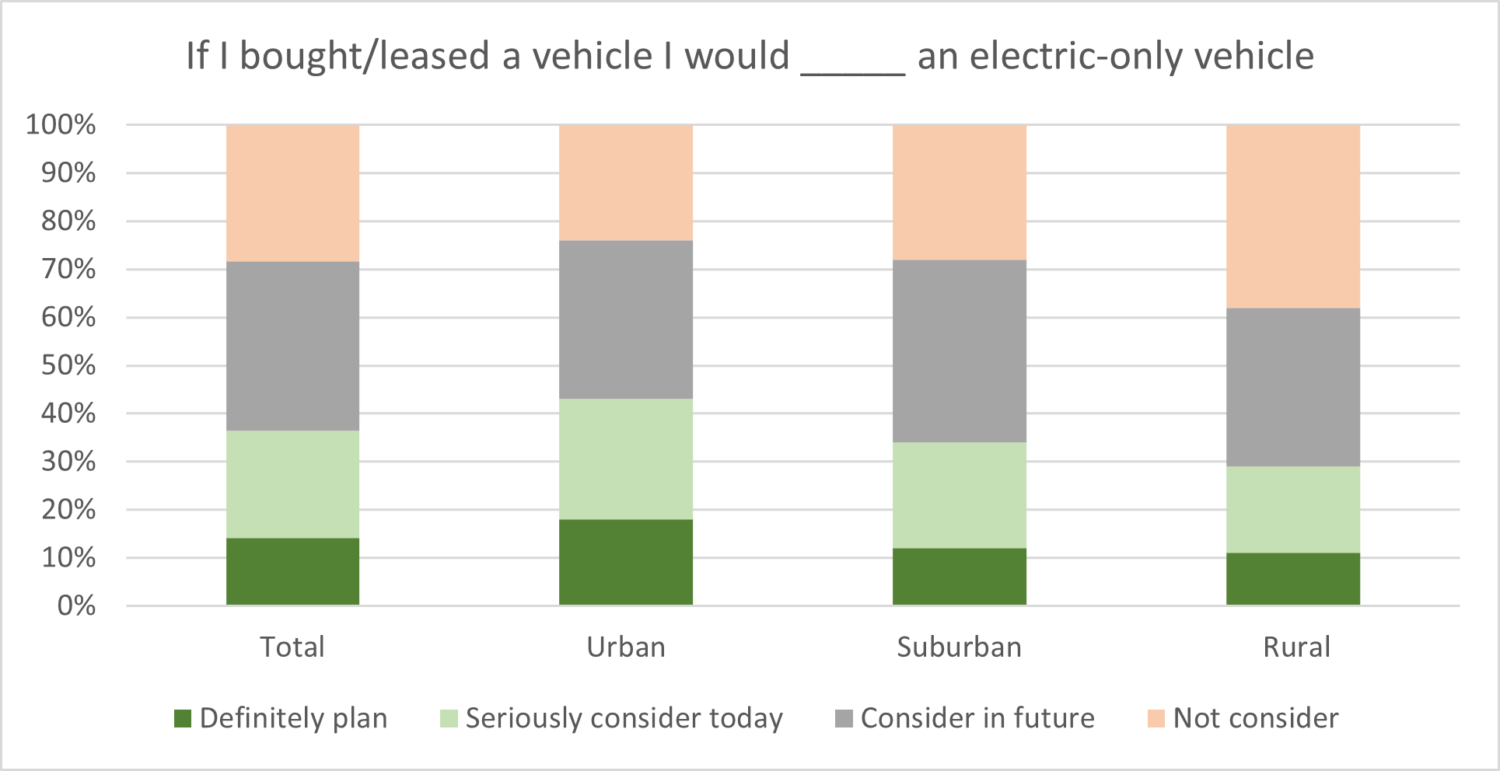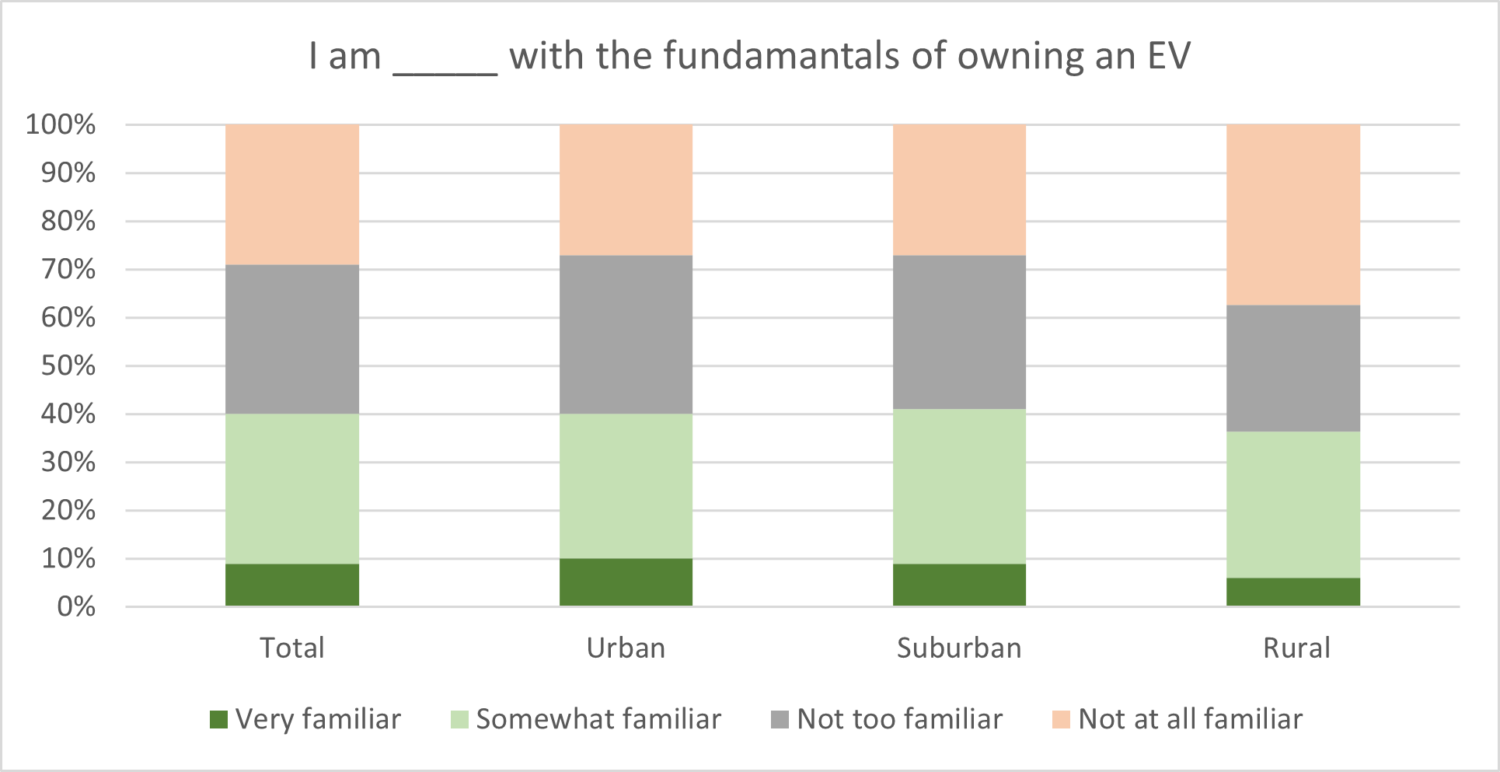Regardless of where we live, we should all have the opportunity to enjoy the benefits provided by electric vehicles. These benefits range from the reduced cost of operation, the reduced need for maintenance and the improved performance, to the fact that electric vehicles have no tailpipe emissions. Everybody’s health stands to gain from reducing local air pollution from tailpipes: communities located near roads, families getting into a car in their garage, children boarding a school bus, and anybody in the vicinity of an idling vehicle. The planet stands to gain too, as EVs emit about half the global warming emissions of a comparable gasoline-powered vehicle, and transportation is the largest emitter of global warming emissions in the U.S., with passenger cars in the lead.
The goal of a clean and equitable transportation system that benefits everybody cannot be achieved without the inclusion of rural areas, which make up 97 percent of our country’s land area, have 70 percent of our roads and are home for approximately 46 million people. There is a large EV adoption gap between rural and urban areas in the U.S. This becomes clear when we examine EV shares of new 2019 vehicle registrations by metropolitan area. In vast swathes of the country, these shares are less than 1 percent, while in the most populous metropolitan areas the shares are from 3 percent to more than 10 percent (look at the map on page 9 of this ICCT report).
Ironically, the adoption of electric vehicles is lagging precisely where drivers stand to gain the most. Rural drivers face unique transportation challenges, which I discussed in a previous blogpost. They are more dependent on their cars due to infrequent transit service and limited access to app-based services. Fuel savings for rural households are larger than for urban households, because trips in rural areas are longer than in urban areas, and vehicles tend to be older and less efficient, requiring more fuel per mile, EVs require fewer trips to a mechanic for repairs and maintenance. Because of the high torque and low center of gravity, they have excellent performance, which is important on rough, curvy and steep roads. Plus, some vehicles, such as the F-150 Lightning, are set up to export power, becoming a potential backup generator, right there in one’s garage.
What is to be done to address this adoption gap? In order to design good policies to support the electrification transition, we first need to understand the root causes of this slow adoption in rural areas. Last year UCS teamed up with Consumer Reports, EVNoire and GreenLatinos to administer a nationally representative survey of 8,027 US adults on the experience, knowledge, and expectations Americans around the country have about EVs. How much interest and familiarity is there for EVs? What are the barriers and motivating factors which influence making the switch?
I will look at the results from the point of view of urbanicity, focusing on rural areas (a colleague of mine examined preferences for and barriers to EV adoption by different racial groups). One of the main takeaways is that there is plenty of interest in rural areas, but there is a huge knowledge gap about what it is like to own an EV.
The number of people who would definitely buy or lease an EV has more than tripled since 2020
A striking result from the survey is that slow adoption rate in rural areas is not for lack of interest in EVs. In a nationally representative 2020 survey, across urban, suburban and rural areas, 4 percent of the respondents with valid driver’s licenses said they would definitely plan to get an EV for their next vehicle. In the latest survey, which was fielded in early 2022, this share has increased from 4 percent overall to 11 percent in rural areas and 18 percent in urban areas. An additional 18 percent of rural dwellers and 25 percent of urban dwellers would seriously consider buying or leasing an EV if they were to get a vehicle today. When considering respondents who would definitely plan and seriously consider (not including those who are open to getting one in the future), this adds up to 29 percent of rural drivers who would at least seriously consider buying or leasing an EV.

Lack of familiarity with EVs
So why are these explicit expressions of interest not reflected in increased adoption rates in rural areas? It is instructive to consider how different the experience of buying and owning an EV can be compared to a gasoline-powered vehicle. These differences include charging logistics vs. fueling at a gas station, logistics and frequency of maintenance and repairs, concerns about costs, and questions about performance.
The survey uncovers that there isn’t sufficient familiarity with EVs in rural areas. The overwhelming majority of respondents – 96 percent – has never owned or leased an EV. Only 6 percent said they were very familiar with the fundamentals of buying and owning an EV, while 30 percent said they were somewhat familiar. One of the reasons for this lack of familiarity could be the scarcity of EVs in rural areas: only 27 percent of rural dwellers have seen an EV in their neighborhood in the past month compared to more than half of urban dwellers, and even fewer have a friend, relative or co-worker who owns an EV. A whopping 90 percent of rural dwellers have never been a passenger in an EV, and almost nobody has ever driven one.
There is much work to be done in the dissemination of information about EVs in both urban and rural areas to help guide prospective EV drivers in this big transition to electrification, and rural drivers are currently the least exposed to this type of information.

Charging, range and cost are top concerns for respondents who weren’t already planning to get an EV
Charging logistics
The survey indicates that public charging is at the top of people’s minds in both rural and urban areas. 60 percent of respondents living in both rural and urban areas listed charging logistics as a potential factor that could prevent them from getting (buying or leasing) an EV. The second top general concern is range, which I talk about below. When it comes to charging, respondents living in rural areas were concerned mainly with the availability of public charging stations, but would also be encouraged by the availability of free charging and fast-charging to get an EV.
Looking at the numbers on concerns about charging, 63 percent of rural dwellers said that what is most likely to hold them back is the lack of enough public charging stations, compared to 58 percent of urban dwellers (the second top charging concern is home charging, which I talk about below). The fact that public charging is very much on all drivers’ minds comes up again when respondents were asked to choose among the charging options that would most likely encourage them to get an EV. In this case, free public charging stations is the top encouragement, with 48 percent of rural and 53 percent of urban dwellers listing this as a top choice out of two (the second is the ability to charge at home).
Fast-charging is another important option that would likely encourage respondents to get an EV, with more urban dwellers expressing this sentiment: 47 percent of urban dwellers listed this as the third charging option (after free public charging and the ability to charge at home), that would encourage getting an EV, compared to 40 percent of rural dwellers.
Now let us look at current charging infrastructure initiatives. At the federal level, the Bipartisan Infrastructure Law (BIL) includes $7.5 billion in funding for charging infrastructure: the National Electric Vehicle Infrastructure Formula (NEVI) Program will provide $5 billion to states, and an additional $2.5 billion will be distributed through a competitive grant program, which includes a community grant program prioritizing rural and disadvantaged communities. In addition, the Inflation Reduction Act (IRA) has a tax credit for businesses or individuals investing in fueling infrastructure that run on certain so-called alternative fuels, a category that includes electricity, and therefore supports EV charging infrastructure. There are also opportunities for investments at the state and local levels, including utility programs.
Home charging is the next factor that could potentially prevent rural dwellers from getting an EV, after the concern about insufficient public charging stations. This is a surprising result, since 73 percent of respondents in rural areas live in detached one-family houses, which are likely to have parking spaces or garages with a regular 120V outlet available. However, the survey also reveals that 34 percent of rural dwellers who have private, off-street parking or dedicated spot do not have access to any kind of outlet at these locations, and about one quarter of rural dwellers rent their home, a factor that could make infrastructure upgrades more difficult. Therefore, even though home charging infrastructure for Level 2 chargers is important, so is supporting home electrical infrastructure upgrades for all rural homes.
Range
Fifty-five percent of rural dwellers listed range as a top concern (second to charging logistics), even if the vast majority of respondents – 87 percent – said they have round trip commutes that are less than 50 miles, which can be easily covered by all EV models on the market today. This concern should be somewhat allayed once more charging stations are available, and as people become aware of the availability of EV models with increased range. Automakers are ramping up development of electric models, partially motivated by state-level clean car regulations as well as by increased competition, so a wider variety of EV offerings are available or in the works, including pick-up trucks such as the electric version of the extremely popular Ford F-150, and others from Rivian, Lucid and VinFast.
Cost
Fifty-two percent of rural dwellers listed this as a top concern (after charging logistics and range). Among respondents who said that cost-related factors would prevent them from getting an EV if they were to get one today, purchase price was the top factor, a concern which depends in part on how much people know about incentives. In rural areas, only 28 percent of people had heard about tax rebates/discounts at the time of purchase (compared to 37 percent in urban areas), and a similar percentage had heard about tax credits which can be applied at a later time. Even fewer had heard about exemptions from vehicle emission inspections, discounts to install a home charger and discounted charging rates. In urban areas, many more people knew about these incentives. After purchase price, the costs of maintenance and repair, of battery replacement, of installing a home charger, of charging costs at home or at public chargers were the next cost concerns, in that order.
The Inflation Reduction Act could be a game-changer. The tax credit for a new EV is still up to $7,500. Of particular relevance for rural areas, where households spend a larger fraction of their total income on transportation, is the new tax credit of up to $4,000 for used EVs. About two-thirds of vehicle sales in the U.S. are used cars and trucks.
Not being able to fix car oneself or at local mechanic
Forty-three percent of rural dwellers listed this as a top concern, fourth in the list of factors that could prevent someone from getting an EV. It is important for prospective EV buyers or leasers to know that EVs require less maintenance and repair than gas-powered vehicles. However, they do need service and repairs from time to time, and it is harder to find EV repair shops and licensed dealerships with trained technicians in rural areas.
Battery replacement and the associated costs are another important concern. When asked what cost-related factors would prevent them from getting an EV, almost one third of rural dwellers mentioned battery replacement costs. Batteries do degrade over time, but this process is slow, battery technology is improving and EV batteries last as long as gas-powered cars, if not longer.
Performance in cold weather
Thirty-six percent of rural dwellers listed this as a top concern, fifth in the list of concerns. Drivers need to be made aware that cold weather affects all kinds of vehicles, whether or not they are electric. In EVs, slower battery chemistry in cold temperatures and other factors lead to a decrease in winter ranges and an increase in charging times. Auto manufacturers are adding technologies that improve the thermal resistance of batteries in extreme temperatures, and utilizing more efficient heating and cooling solutions, such as heat pumps. The exact percentage of range loss depends on the model and weather conditions, but according to a recent Norwegian study, EVs lose on the average about 20 percent of their range, while the EPA estimates that gasoline-powered cars lose 15 percent in efficiency in cold weather. Note that these losses are not that different from each other. It is also important for people to be reminded that in Norway, known for its cold winters, 70 percent of car sales are electric.
After having talked about the five main factors that people in rural areas said could prevent them from getting an EV, it is good news that the survey identified factors about the EV experience that people find encouraging. Three in 10 respondents living in a rural areas said that the fuel savings would be a top reason encouraging them to get an EV today, while a slightly smaller percentage said lower overall lifetime ownership costs, and lower maintenance costs than owning a gasoline-powered vehicle. In a follow-up question asked of rural respondents who said that avoiding gasoline is a reason that would most encourage them to get an EV, almost seven in 10 said it is because gasoline is too expensive. The awareness about fuel and maintenance savings is critical, as lower costs are indeed a major difference between owning a gasoline vehicle compared to an EV.
Many concerns can be alleviated with more access to information
For policies to effectively increase ownership of EVs in rural areas, education and community outreach must be responsive to the concerns of rural communities. Information should be disseminated about the experience of owning an EV, and in particular about programs and purchase incentives available in rural areas. The five top concerns, as identified by the survey, must be prioritized when planning for the dissemination of information. Some recommendations are:
- automakers can offer training for auto dealers, sharing Information that demystifies EVs, ensures that consumers are aware of incentives that decrease costs and helps consumers optimize use of existing charging infrastructure
- offer training for EV technicians
- offer education for local community leaders, local officials, schoolteachers and students and prospective EV buyers
- make use of channels such as community-based organizations, clinics, schools, and faith-based organizations
- make use of local radio and television news channels
- disseminate brochures and fliers, including the re-writing of technical information (from automakers, non-governmental organizations, and governmental agencies) aimed at a broader audience
- disseminate the existence of EV-specific websites, online or print news articles, reviewer sites such as YouTube videos and Forums (in a recent survey, people who intended to buy an EV listed the sources of information that were most valuable for them)
- raise awareness through ride and drive events and nationwide celebrations such as the National Drive Electric Week
Understanding the differences between buying and owning an EV compared to a gasoline-powered vehicle is extremely important. A smooth transition to electrification requires envisioning an electric future, and having answers for many questions, such as: Will the range of my vehicle meet my driving needs? Where will I find a public charger? How will an EV impact my power bill? How affordable will maintenance be? People find their gasoline cars convenient, powerful, reliable and safe, but EVs have all these attributes as well, and have further benefits. Knowledge about EVs is important in so many ways. It helps people envision a future which may currently look unfamiliar, and helps people understand that electrification is practical, has long-term economic benefits, is critical to improve human health and vastly reduces vehicle climate-damaging emissions.
In rural areas, overall consumer awareness is still below the country average. Rural consumers are lacking key knowledge that could help them alleviate their concerns and better understand the overall benefits of making the switch to an EV. We must ensure that rural consumers have the information they need to help everybody move towards an electric future.

